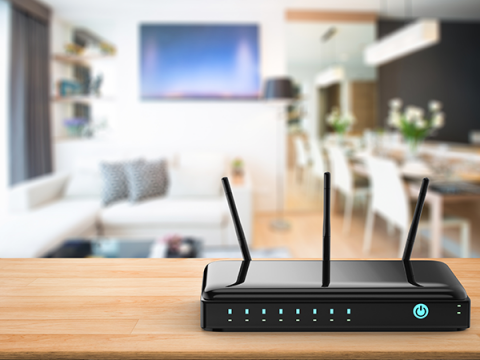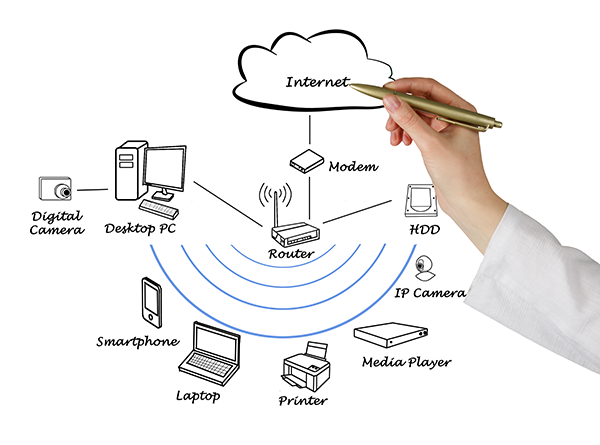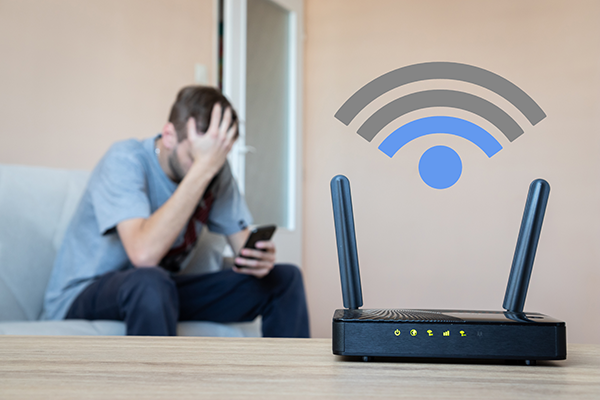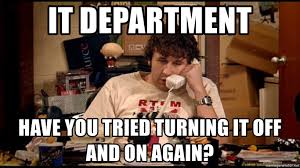You come home from a long day at the office only to find that your Wi-Fi connection is slow, or even worse, not working at all. We'll go over the most common reasons you might be experiencing slow Wi-Fi or interruption of service, and most importantly, tips for fixing it yourself.
What is Wi-Fi?
Wi-Fi is a type of wireless networking technology that uses radio waves to connect computers and devices to the internet rather than a standard physical connection through a data cable. Wi-Fi Alliance, the organization that certifies Wi-Fi enabled products and devices, defines Wi-Fi as "wireless local area network (WLAN) products that are based on the Institute of Electrical and Electronics Engineers' (IEEE) 802.11 standards."
How Does Wi-Fi Work?
To make it easier to conceptualize the process, let's envision your computer as the "sender" of information, and the router as the "receiver". Your computer's wireless network card translates data into a radio signal and transmits it to the router. The router receives the signal and decodes it, then sends the signal to your modem over a wired ethernet connection. Of course, this process also works the opposite way, with the router as the "sender", and your computer or device as the "receiver".
Some providers offer a modem and router combo unit in which the router and modem are contained within the same device, or you may have purchased one yourself. All of the suggestions below still apply to these combo units, there are just fewer steps involved.
Now that we've covered the essentials of what Wi-Fi is and how it works, here are the top 10 reasons your Wi-Fi connection may not be functioning as it should:
10. Your Wi-Fi is slow or nonexistent in some rooms
If your connection seems fine in some rooms, but it's slow or won't connect in other rooms, make sure nothing is blocking your Wi-Fi signal. Your router is constantly broadcasting radio waves in every direction, so be sure nothing is physically obstructing the signal, and consider moving the router to a location in the middle of your home if possible. Ensuring that the router is at the center of your usage area should improve coverage and reception throughout your entire home.
If you use an antenna to boost your signal, you can adjust it to see if it resolves the problem. Other wireless router signals could be interfering with your router if you live in an apartment or other multi-tenant building. There are plenty of free software solutions to check for those problems like NetSpot on Mac, Android, and Windows) or Wi-Fi Analyzer for Android that will show you all wireless networks in range and which channel they are using. If you find that your router is overlapping with another network nearby, try switching to another channel that's not being used.
If you rely on a Wi-Fi repeater and it's not sending a signal in one or more rooms, try unplugging it for about 30 seconds and then plugging it back in again.
If none of these suggestions help, your home could be too large for just one router to cover, or your interior walls could be too thick. Adding a wireless repeater (or using a second wireless router as a repeater) can help to extend the effective range of your central router.
9. Your...internet...speeds...are...consistently...slow
No matter where you try to connect to the Wi-Fi in your home, your speeds are consistently slow. Diagnose the problem yourself by plugging a PC or laptop directly into your modem and check your speed using a site like speedtest.net. If your connection is still slow, it's probably your Internet connection and not a problem with the router. Contact your ISPs tech support line as soon as possible. Support technicians usually have access to diagnostic tools that can trace your connection and perform remote tests on your modem and router.
If tech support can't seem to find the problem, you can try to reset your modem and router to factory defaults (warning: this may delete any customized settings like networks, device names, and sometimes even passwords). Most routers and modems have a recessed factory reset button that you must hold down for about 30 seconds. Use the documentation that came with your device to make sure it gets configured properly when you boot it up again.
Is your modem right for the speed you should be getting? Check with your ISP to make sure the modem and router you're using are compatible with the speeds you're subscribed to, especially if you bought your own equipment or if you've been leasing the same equipment from your ISP for a year or more.
If none of these suggestions work to solve your slow internet speeds, and your internet seems fine when you connect to the internet through a hard line to the modem, it's possible your router could be dying, and it's time to buy a new one.
8. Nothing connects to your Wi-Fi
If you can’t connect to your Wi-Fi with any device, try plugging your laptop, computer, or gaming console into the router directly using a networking cable and see if you can connect to the internet that way. If you can connect to the internet by plugging directly into the router, you know that your Wi-Fi is the problem. If you can't get a connection when plugged directly into the router, try connecting directly to the modem with your networking cable. If you can connect through the modem, your router may be offline. Try rebooting it. If that doesn't fix the problem, your router may need to be replaced. If you can't get an internet connection by plugging directly into your modem, your internet connection is probably down and you should contact your ISP.
7. Your device won't connect to Wi-Fi
If your device was previously connected to Wi-Fi, but now it won't connect, it's probably nothing serious. To restore connectivity on the device, turn off the Wi-Fi on the device itself and then turn it back on. If that doesn't fix the problem, turn off the router and turn it back on again. If the device still won't connect, power it down completely, then turn off the router and turn it back on again. Power the device up again, and test it to see if it's connecting to your router. If you've never connected the device wirelessly before, be sure it's Wi-Fi compatible.
If none of these solutions work, you may have to reconfigure your network settings on the device.
6. Your connection drops randomly
Random connection drops are usually caused by interference of some kind. Smart appliances, microwaves, cordless phones, and even baby monitors could be obstructing your Wi-Fi connection. Limit the use of these devices in areas where they could interrupt your wireless signal. Random Wi-Fi drops could also be a sign that your internet connection itself is dropping, so if you have already made sure there are no devices interfering with your signal, try plugging a hard line into your laptop or PC. If your connection is slower than it should be or if it's still constantly dropping, the problem could be on your service provider's end.
5. Your Wi-Fi network disappears
If your usual Wi-Fi network suddenly stops appearing on your devices, it's possible your router has reset itself. Look at the available connections on your device. Is there an unlocked network with the same name as the brand of router you own? It could be yours. Even if your router isn't appearing as an available connection, connect a laptop or PC to it with an ethernet cable, then use the guide that came with your router to reconfigure your network.
4. You can connect to Wi-Fi, but not to the internet
You probably just need to reset your modem. Unplug it and then plug it back in. Do the same for your router. Check your connection by plugging a laptop or PC into the modem directly with a networking cable. If this works, then you know that your router is the problem, and may need to be reset. If there’s still no internet connection and you're plugged directly into the modem, contact your ISP because it's likely you're experiencing a service outage.
3. Your router drops connection frequently and needs to be restarted
If you find that your router is constantly needing to be restarted, try resetting it to its default settings. Most routers have a tiny, recessed “reset” button that you have to press down with something small, like a pin or the end of a straightened paperclip. Hold the button down for about 30 seconds, and the router should restore itself to default factory settings. You will have to reconfigure your network, so be sure to follow the directions included with your router, and be sure to save a copy of your network setting before you reset your router.
If this solution doesn’t work for you, it's possible your router needs to be replaced.
2. Wi-Fi works on every device but your cell phone
Have you installed an update on your phone recently? If so, roll back to the previously installed firmware version. If this doesn't seem to fix the problem, make sure you're trying to connect to the right network. If you still can't connect with your cell phone, try restarting it. You can also cycle your router at the same time to make sure it isn't causing the problem. If you can't connect to any wireless router with your phone, it's possible that there is a problem with your phone's network card, and you should take it to your cell service provider or manufacturer for troubleshooting and repairs.
1. You forgot your Wi-Fi password
If you lose your Wi-Fi password and you can't remember it, or you didn't write it down somewhere, there's not much you can do except reset your router. See #3 above for instructions about resetting your router. When you configure your new network settings, be sure to write down your router name and password in a place you'll remember for the next time you need it. Make sure you don't choose a password that's easy to guess because that could leave your router open to attacks from highjackers. Click here to learn more about staying safe online.





